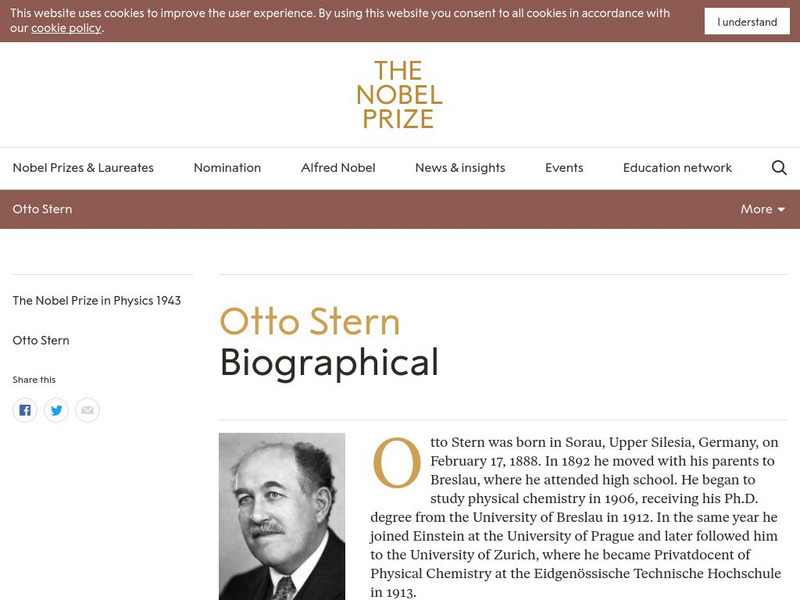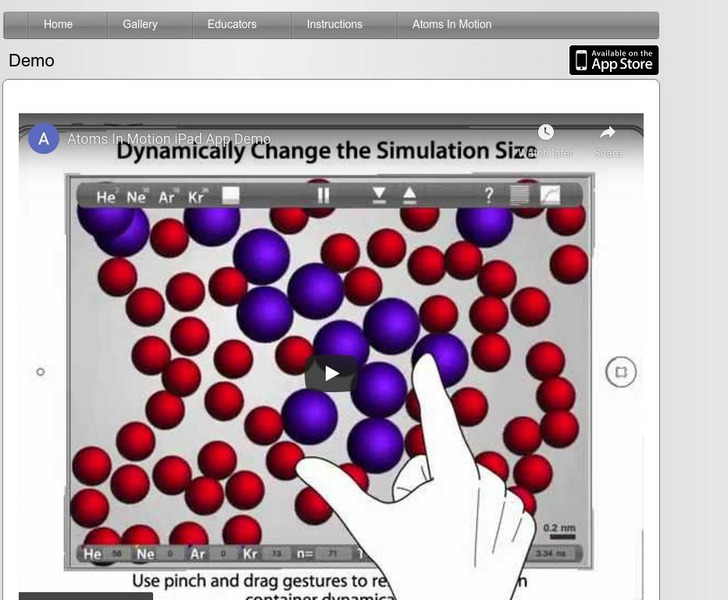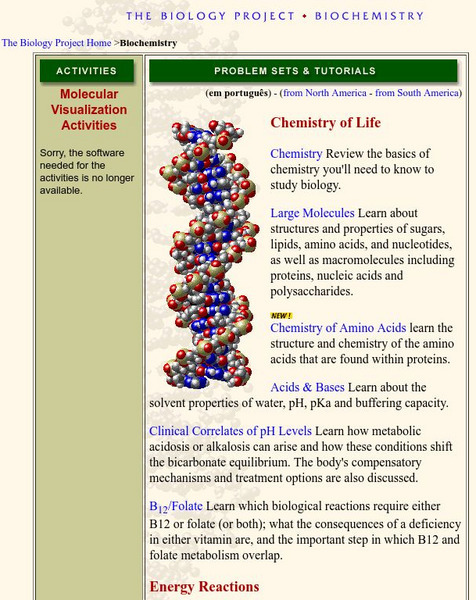Concord Consortium
Concord Consortium: Stem Resources: Cellular Respiration
Web-based activity provides an opportunity for students to study cellular respiration in an up-close and personal way. By following atoms and molecules through an interactive animation, they will be able to see the changes that take...
Other
University of Kansas: Quarked!: Matter Mechanic
Build elements and molecules using neutrons, protons, and electrons. Choices include helium, carbon, oxygen, aluminum, water, and salt.
Nobel Media AB
The Nobel Prize: Otto Stern Biographical
This is a brief biography on the life and scientific work of Otto Stern, a physicist honored with the Nobel Prize in physics for his "development of the molecular ray method and his discovery of the magnetic moment of the proton."
Khan Academy
Khan Academy: The Mole and Avogadro's Number
An explanation the mole (named for molecule) and Avogadro's Number. One mole of a substance is equal to 6.022 times 10 to 23rd power units of that substance (such as atoms, molecules, or ions). The number 6.022 time 10 to 23rd power is...
ClassFlow
Class Flow: Comparing and Contrasting Matter
[Free Registration/Login Required] This flipchart is a guided activity to help students compare different types of matter: atoms and molecules, elements and compounds, mixtures and solutions. It corresponds to Virginia science SOL 5.4.
American Chemical Society
Middle School Chemistry: Represent Bonding With Lewis Dot Diagrams
Students draw and interpret Lewis dot diagrams for individual atoms and both covalent and ionic compounds.
Wisc-Online
Wisc Online: Lewis Dot Structures of Covalent Compounds
Short slide show provides basic information about drawing Lewis dot structures for covalent compounds. Starts with anatomy of the atom, and then shows the relationship between atomic particles and the Periodic Table of Elements. Offers...
Other
Atoms in Motion: All Matter Is Made of Atoms
Atoms are very, very small. Atoms are so small that it is often said that there are as many atoms in a single grain of sand as there are grains of sand on all of the world's beaches - certainly a difficult thing to prove, but you get the...
Science4Fun
Science4 Fun: Molecules
What is a molecule? Discover why molecules are formed and other fun facts.
Museum of Science
The Atom's Family: Phases of Matter
Help the Phantom choose a material and observe the changes at different temperatures in the molecule chamber. What happens to the elements or molecules as the temperature changes?
Upper Canada District School Board
Tom Stretton's Advanced Placement Chemistry: Atoms, Molecules and Ions
This online textbook chapter provides learners with advanced-level material on the structure and relationships between atoms, molecules and ions.
CK-12 Foundation
Ck 12: Plix: Carbohydrates: A Glucose Molecule
[Free Registration/Login Required] Drag the groups of hydroxy and hydrogen atoms to their proper locations to make a complete glucose molecule.
CK-12 Foundation
Ck 12: Life Science: 2.1 Elements and Compounds
Learn how basic elements form molecules to support life.
Simon Fraser University
Chem1 Virtual Textbook: What Is Chemistry All About?
Covering a range of eight topics related to chemistry, this resource provides a wealth of information complete with pictures, charts, graphs, and examples. Includes information on elements, compounds, atoms, molecules, structures,...
Other
Atoms in Motion: Demo
Demonstration of the "Atoms In Motion" app running on an iPad simulator. User interactions and gestures control the entire simulation.
Simon Fraser University
Chem1 Virtual Textbook: The Basics on Atomic Theory
As part of the Virtual Textbook, this site examines all things related to Atomic Theory including information on atoms, molecules, formulas, equations, nomenclature, and more.
University of Arizona
University of Arizona: Biochemistry
Problem sets, tutorials, and activities related to biochemistry.
American Chemical Society
American Chemical Society: Hompage
ChemCenter, available from the American Chemical Society, provides chemistry news, reference sources and other public services.
Concord Consortium
Concord Consortium: Newton's Laws at the Atomic Scale
Explore how Newton's three laws apply to the world of atoms and molecules. Start with the originally contradictory observation of Brownian motion. Then, each law is addressed at the atomic level.
University Corporation for Atmospheric Research
Ucar: Whole Body Ozone Chemistry
In this activity, students will play the roles of various atoms and molecules to help them better understand how ozone is formed in the earth's stratosphere.
CK-12 Foundation
Ck 12: Chemistry Simulation: Air Matters
[Free Registration/Login Required] Explore the composition of air and learn about the different atoms and molecules that we breathe every day.
National High Magnetic Field Laboratory
Magnet Academy: Mass Spectrometer (Dual Sector)
Mass spectrometers are machines that give scientists a look at the composition and origin of a material by analyzing and quantifying its atoms and molecules. This tutorial shows how a dual sector mass spectrometer works. (Java tutorial)
National High Magnetic Field Laboratory
Magnet Academy: Mass Spectrometer (Single Sector)
Mass spectrometers are machines that give scientists a look at the composition and origin of a material by analyzing and quantifying its atoms and molecules. This tutorial shows how a single sector mass spectrometer works. (Java tutorial)
Other
Chemguide: Electronegativity
This page explains what electronegativity is, and how and why it varies around the Periodic Table. It looks at the way that electronegativity differences affect bond type and explains what is meant by polar bonds and polar molecules.
Other popular searches
- Gumdrop Atoms and Molecules
- Making Atoms and Molecules
- Science, Atoms and Molecules
- Science Atoms and Molecules
- Atoms and Molecules Lesson
- Atoms and Molecules Musical
- Combining Atoms and Molecules
- Molecules and Atoms
- Atoms Molecules and Element
- Courting Atoms and Molecules
- Elements Molecules and Atoms


















